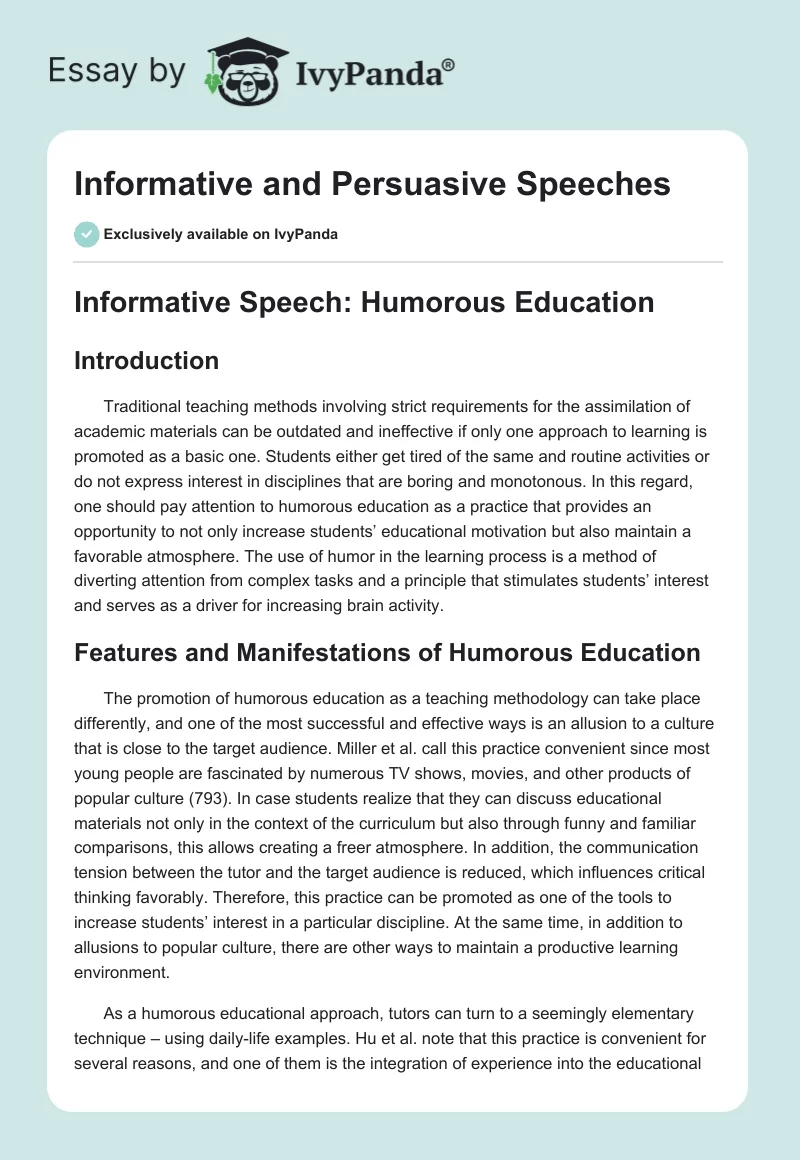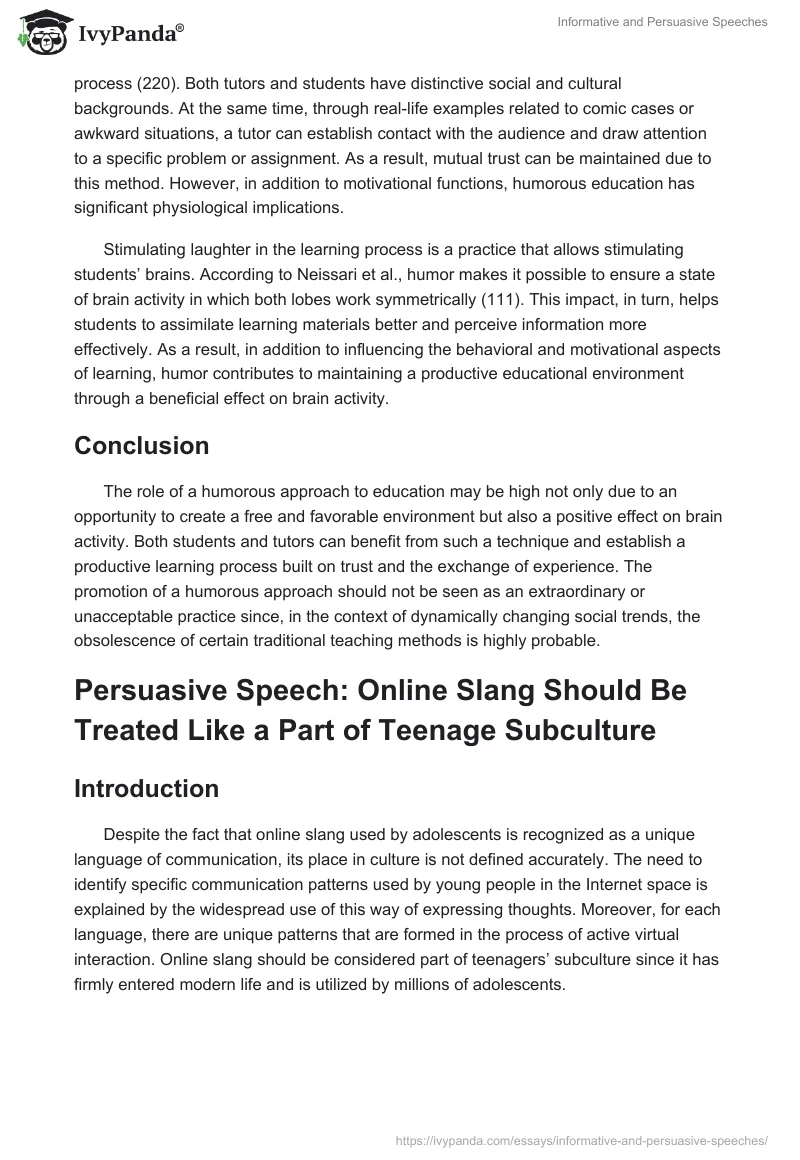Informative Speech: Humorous Education
Introduction
Traditional teaching methods involving strict requirements for the assimilation of academic materials can be outdated and ineffective if only one approach to learning is promoted as a basic one. Students either get tired of the same and routine activities or do not express interest in disciplines that are boring and monotonous. In this regard, one should pay attention to humorous education as a practice that provides an opportunity to not only increase students’ educational motivation but also maintain a favorable atmosphere. The use of humor in the learning process is a method of diverting attention from complex tasks and a principle that stimulates students’ interest and serves as a driver for increasing brain activity.
Features and Manifestations of Humorous Education
The promotion of humorous education as a teaching methodology can take place differently, and one of the most successful and effective ways is an allusion to a culture that is close to the target audience. Miller et al. call this practice convenient since most young people are fascinated by numerous TV shows, movies, and other products of popular culture (793). In case students realize that they can discuss educational materials not only in the context of the curriculum but also through funny and familiar comparisons, this allows creating a freer atmosphere. In addition, the communication tension between the tutor and the target audience is reduced, which influences critical thinking favorably. Therefore, this practice can be promoted as one of the tools to increase students’ interest in a particular discipline. At the same time, in addition to allusions to popular culture, there are other ways to maintain a productive learning environment.
As a humorous educational approach, tutors can turn to a seemingly elementary technique – using daily-life examples. Hu et al. note that this practice is convenient for several reasons, and one of them is the integration of experience into the educational process (220). Both tutors and students have distinctive social and cultural backgrounds. At the same time, through real-life examples related to comic cases or awkward situations, a tutor can establish contact with the audience and draw attention to a specific problem or assignment. As a result, mutual trust can be maintained due to this method. However, in addition to motivational functions, humorous education has significant physiological implications.
Stimulating laughter in the learning process is a practice that allows stimulating students’ brains. According to Neissari et al., humor makes it possible to ensure a state of brain activity in which both lobes work symmetrically (111). This impact, in turn, helps students to assimilate learning materials better and perceive information more effectively. As a result, in addition to influencing the behavioral and motivational aspects of learning, humor contributes to maintaining a productive educational environment through a beneficial effect on brain activity.
Conclusion
The role of a humorous approach to education may be high not only due to an opportunity to create a free and favorable environment but also a positive effect on brain activity. Both students and tutors can benefit from such a technique and establish a productive learning process built on trust and the exchange of experience. The promotion of a humorous approach should not be seen as an extraordinary or unacceptable practice since, in the context of dynamically changing social trends, the obsolescence of certain traditional teaching methods is highly probable.
Persuasive Speech: Online Slang Should Be Treated Like a Part of Teenage Subculture
Introduction
Despite the fact that online slang used by adolescents is recognized as a unique language of communication, its place in culture is not defined accurately. The need to identify specific communication patterns used by young people in the Internet space is explained by the widespread use of this way of expressing thoughts. Moreover, for each language, there are unique patterns that are formed in the process of active virtual interaction. Online slang should be considered part of teenagers’ subculture since it has firmly entered modern life and is utilized by millions of adolescents.
The Need for Recognition
For adults, the use of specific slang set expressions is less typical than for adolescents. However, this does not mean that the teenage language of virtual communication cannot be regarded as an integral element of their culture. In this regard, the relevance of online slang recognition should be considered in the context of its role and application features based on the findings from credible sources.
Online slang should be regarded as an element of adolescent subculture due to the adoption of such a form of communication. According to Yoga Suryanto, “a speech community is a grouping of individuals by their participation in social domain” (3). Since the predominant number of teenagers interact with one another actively in the online environment, this form of communication is recognized as convenient and widespread. Therefore, the recognition of slang by the community identifies it with an element of subculture.
A special principle of the formation of online slang expressions is also an incentive for its recognition. Yoga Suryanto gives different examples of various structures and abbreviations, for instance, blending, misspelling, and others, thereby confirming the ordered nature of word formation (5). As a result, the vocabulary of online slang can be structured, which describes it as a unique and relatively ordered component of teenage subculture.
Another reason that explains the need for online slang recognition is the frequency of its use. Izmaylova et al. analyze this phenomenon and note that, according to the results of their research, the majority of respondents (58%) use certain slang expressions not only on the Internet but also in real life (77). The frequency reflects adherence to particular communication patterns that are advanced widely by a specific community.
Finally, as an argument, the variability of slang patterns may be mentioned. As Abramova et al. note, teenagers do not distinguish between online and real-life interaction (81). In other words, the transfer of language structures from the virtual space into ordinary communication is a common practice. Therefore, adolescents’ unique language has the right to be considered part of their subculture as a component of everyday life.
Solution
While taking into account the aforementioned reasoning, one should take into account the arguments in support of the inclusion of online slang in teenagers’ subculture. For this purpose, in addition to the analysis of formation features, individual language structures can be included in general dictionaries. This will allow identifying specific slang words with real ones and give many people an opportunity to get acquainted with the features of adolescents’ Internet communication.
Conclusion
In case adolescents’ online slang is perceived as an element of their subculture, this will allow adults to establish closer contact with their children and understand specific language structures. In Figure 1, one can see individual expressions that can be adopted by Internet users (Slaughenhaupt). Thus, the recognition of online slang should be implemented due to the widespread use of numerous structures both in the virtual environment and in real life. The public can try to decipher individual expressions and draw conclusions about the convenience of specific abbreviations and their relevance in online communication.

Works Cited
Abramova, Sofia, et al. “Speech Behavior and Multimodality in Online Communication among Teenagers.” KnE Social Sciences, 2020, pp. 75-83.
Hu, David L., et al. “Humour Applied to STEM Education.” Systems Research and Behavioral Science, vol. 34, no. 3, 2017, pp. 216-226.
Izmaylova, Guzel A., et al. “Linguistic and Social Features of Slang.” International Journal of Scientific Study, vol. 5, no. 6, 2017, pp. 75-78.
Miller, Julia L., et al. “Humorous Materials to Enhance Active Learning.” Higher Education Research & Development, vol. 36, no. 4, 2017, pp. 791-806.
Neissari, Malihe, et al. “Humorous Videos and Idiom Achievement: Some Pedagogical Considerations for EFL Learners.” Iranian Journal of Language Teaching Research, vol. 5, no. 3, 2017, pp. 109-127.
Slaughenhaupt, Makenna. “Slang and Social Media.” The Valhalla Voice, 2018, Web.
Yoga Suryanto, G. “The Use of Slang Words by Gamers in the Game Online.” Language Horizon, vol. 4, no. 1, 2016, pp. 1-8.


